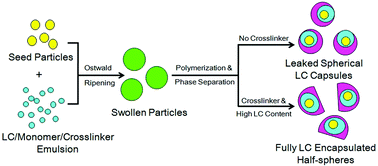Stephen Z. D. Chengb
a Suzhou Key Laboratory of Macromolecular Design and Precision Synthesis, Jiangsu Key Laboratory of Advanced Functional Polymer Design and Application, College of Chemistry, Chemical Engineering and Materials Science, Soochow University, Suzhou 215123, P. R. China
b Maurice Morton Institute and Department of Polymer Science, The University of Akron, Akron, USA
c Hollenderasen 28, Sandefjord, Norway
Polym. Chem. 2015, 6, 2551-2559
We demonstrate here a novel synthetic approach towards micron-sized poly(methyl methacrylate) particles encapsulated with smectic liquid crystals (LC) via emulsion polymerization using a diffusion-controlled swelling method. The effects of different emulsifiers, seed particles, crosslinker content, LC content and polymerization temperatures on LC capsules' size and shape were studied to obtain the optimal conditions. The results revealed that polystyrene particles were better seed particles than poly(butyl acrylate) seed particles, yet they need more time to achieve Ostwald ripening. By introducing a high amount of crosslinking agent, the LCs can be fully encapsulated without any leakage, while the capsules' shape changed from spheres to half-spheres when the LC loading in the starting material before polymerization was higher than 30%. The capsule size is about 2 to 10 microns with a broad distribution, as characterized by scanning electron microscopy and polarized optical microscopy. The LC capsules can be fractionated by centrifugation, and narrowly distributed capsules were obtained. The properties of the LC capsules were studied by differential scanning calorimetry, and it revealed that the LC content in the capsules was higher than the initial content in the emulsion.

链接:
//pubs.rsc.org/en/Content/ArticleLanding/2015/PY/c4py01767f#!divAbstract